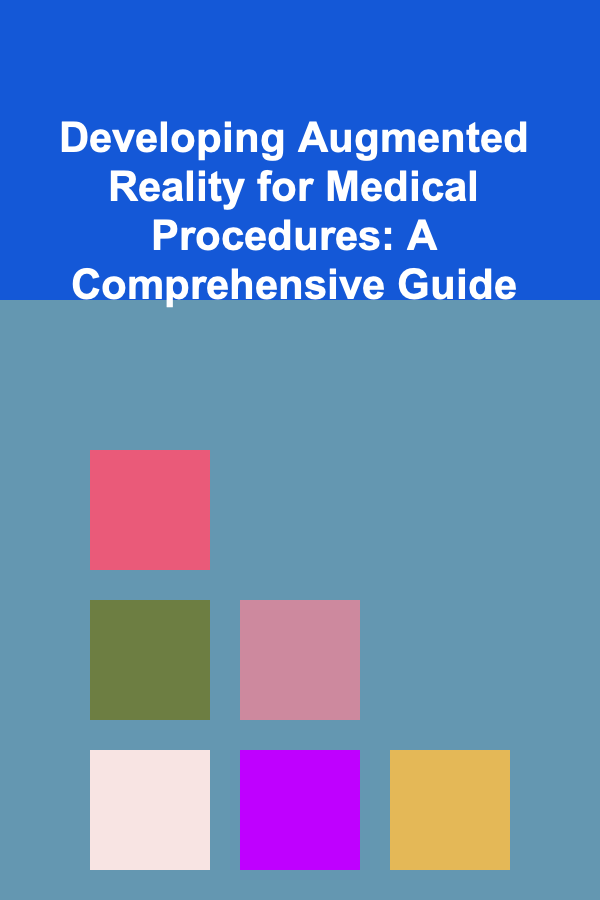
Developing Augmented Reality for Medical Procedures: A Comprehensive Guide
ebook include PDF & Audio bundle (Micro Guide)
$12.99$7.99
Limited Time Offer! Order within the next:

Augmented Reality (AR) is rapidly transforming various industries, and the medical field is no exception. By overlaying digital information onto the real world, AR offers immense potential to enhance precision, improve training, and ultimately, revolutionize medical procedures. This article delves into the intricate process of developing AR applications specifically tailored for medical use, exploring the crucial stages, challenges, and ethical considerations involved.
I. Understanding the Potential of AR in Medicine
Before embarking on the development journey, it's essential to grasp the diverse ways AR can contribute to medical advancements. The technology offers more than just visual enhancements; it provides tools for better decision-making, improved collaboration, and enhanced patient care.
A. Key Applications of AR in Medical Procedures
- Surgical Guidance: AR can overlay 3D models of organs and tissues onto the patient's body during surgery, providing surgeons with real-time guidance and improving accuracy. This is particularly valuable in minimally invasive procedures where direct visualization is limited. Consider a scenario where a surgeon is placing screws in the spine. An AR system could project the optimal trajectory and depth for each screw onto the patient's back, minimizing the risk of nerve damage.
- Medical Training and Education: AR provides immersive and interactive learning experiences for medical students and residents. They can practice complex procedures in a safe and controlled environment, honing their skills without risking patient safety. For example, a student could use an AR headset to practice suturing a virtual wound on a mannequin, receiving immediate feedback on their technique.
- Diagnosis and Treatment Planning: AR can visualize medical imaging data, such as CT scans and MRIs, in 3D, allowing doctors to better understand the patient's anatomy and plan treatment strategies. Imagine a cardiologist using AR to visualize a patient's coronary arteries in 3D, identifying blockages and planning the optimal angioplasty procedure.
- Patient Education and Communication: AR can help patients understand their medical conditions and treatment options. By visualizing complex anatomical structures and procedures in an accessible way, AR can empower patients to make informed decisions about their healthcare. A doctor could use AR to show a patient a 3D model of their knee joint, explaining the location and severity of their arthritis and demonstrating how a knee replacement surgery would address the problem.
- Assisted Living and Rehabilitation: AR can provide real-time feedback and guidance to patients undergoing rehabilitation, helping them perform exercises correctly and track their progress. For instance, a stroke patient could use an AR application to guide them through hand exercises, ensuring they are using the correct muscles and range of motion.
B. Benefits of Integrating AR into Medical Practices
- Improved Precision and Accuracy: AR overlays provide real-time guidance, reducing the margin of error during surgical procedures and other medical interventions.
- Reduced Procedure Time: By providing surgeons with readily available anatomical information, AR can streamline procedures and reduce overall operating time.
- Enhanced Visualization: AR allows doctors to visualize internal structures in 3D, improving their understanding of the patient's anatomy and pathology.
- Improved Patient Outcomes: Ultimately, the combination of enhanced precision, reduced procedure time, and improved visualization leads to better patient outcomes.
- Cost Reduction: While initial investment can be significant, in the long term, AR can reduce costs by minimizing complications, shortening hospital stays, and improving efficiency.
II. The Development Process: A Step-by-Step Guide
Developing AR applications for medical procedures requires a structured approach. The following outlines the key steps involved in the process:
A. Identifying the Need and Defining the Scope
The first step is to identify a specific need within a medical procedure or training scenario that AR can address. This requires close collaboration with medical professionals to understand their challenges and identify areas where AR can provide the most value. Consider these questions:
- What are the current limitations of the procedure or training method?
- How can AR address these limitations and improve outcomes?
- What are the specific requirements for the AR application?
- What data sources are available (e.g., CT scans, MRIs, ultrasound images)?
Clearly defining the scope of the project is crucial. A well-defined scope will help to keep the project on track and ensure that the final product meets the needs of the users. Avoid "feature creep" by focusing on the core functionalities that will deliver the most value.
B. Data Acquisition and Processing
Many AR applications for medical procedures rely on medical imaging data. This data needs to be acquired, processed, and converted into a format that can be used by the AR application.
- Data Acquisition: This involves obtaining the necessary medical imaging data, such as CT scans, MRIs, and ultrasound images. It's crucial to ensure that the data is of high quality and adheres to relevant privacy regulations (e.g., HIPAA in the United States).
- Image Segmentation: This is the process of identifying and isolating specific anatomical structures within the medical images. This can be done manually or using automated segmentation algorithms. For example, segmenting the liver from a CT scan to create a 3D model for surgical planning.
- 3D Modeling: Once the relevant structures have been segmented, they can be converted into 3D models. This can be done using specialized software or libraries. The models should be accurate and detailed enough to provide meaningful information to the user.
- Data Optimization: Medical imaging datasets can be very large, which can impact performance. It's important to optimize the data for AR applications by reducing the polygon count of 3D models and compressing textures.
C. Software Development
The software development stage involves creating the AR application using appropriate programming languages and development tools. This is a multi-faceted process involving several key considerations:
- Choosing a Development Platform: Several AR development platforms are available, each with its own strengths and weaknesses. Popular options include:
- Unity: A versatile game engine that supports a wide range of AR devices and platforms. It offers a robust ecosystem of plugins and assets, making it a popular choice for AR development.
- Unreal Engine: Another powerful game engine known for its high-fidelity graphics and advanced features. It's particularly well-suited for applications that require photorealistic rendering.
- ARKit (Apple): Apple's AR framework for iOS devices. It provides robust tracking and scene understanding capabilities.
- ARCore (Google): Google's AR framework for Android devices. Similar to ARKit, it offers advanced tracking and scene understanding features.
- Vuforia: A widely used AR SDK that supports a variety of platforms and devices. It offers a range of features, including image recognition, object tracking, and environment mapping. The choice of platform will depend on the specific requirements of the project, the target devices, and the development team's expertise.
- Developing the User Interface (UI): The UI should be intuitive and easy to use, allowing users to access the information they need quickly and efficiently. Consider the following principles:
- Clarity: The UI should be clear and uncluttered, avoiding unnecessary distractions.
- Efficiency: Users should be able to perform tasks with a minimum number of steps.
- Accessibility: The UI should be accessible to users with disabilities.
- Context-Awareness: The UI should adapt to the user's context and provide relevant information.
- Implementing Tracking and Registration: Tracking and registration are crucial for accurately overlaying virtual content onto the real world. This involves using sensors, such as cameras and inertial measurement units (IMUs), to track the user's position and orientation. Several tracking techniques are available, including:
- Marker-Based Tracking: Uses predefined markers to track the user's position and orientation. This is a simple and reliable technique, but it requires the presence of markers in the environment.
- Markerless Tracking: Uses computer vision algorithms to track features in the environment without relying on markers. This is a more flexible technique, but it can be less accurate than marker-based tracking.
- Sensor-Based Tracking: Uses sensors, such as GPS and IMUs, to track the user's position and orientation. This technique can be used both indoors and outdoors, but it can be susceptible to drift.
- Integrating Medical Data: The AR application needs to be able to access and display medical data, such as CT scans, MRIs, and patient records. This requires integrating with hospital information systems and ensuring data security and privacy.
- Developing Interaction Methods: Consider how users will interact with the AR application. Options include:
- Gestures: Users can interact with the application using hand gestures.
- Voice Commands: Users can control the application using voice commands.
- Controllers: Users can use handheld controllers to interact with the application.
- Gaze Tracking: The application can track the user's gaze and use it to select objects or perform actions.
D. Testing and Validation
Thorough testing and validation are essential to ensure that the AR application is accurate, reliable, and safe for use in medical procedures. This involves testing the application in a variety of scenarios and with different users.
- Usability Testing: This involves observing users as they interact with the application and gathering feedback on its usability.
- Accuracy Testing: This involves verifying that the AR overlays are accurately registered with the real world and that the medical data is displayed correctly.
- Performance Testing: This involves measuring the performance of the application, such as frame rate and latency, to ensure that it meets the required performance standards.
- Clinical Validation: This involves testing the application in a clinical setting to evaluate its effectiveness in improving patient outcomes. This often requires ethical approval from an institutional review board (IRB).
E. Deployment and Maintenance
Once the AR application has been tested and validated, it can be deployed for use in medical procedures. This involves installing the application on the target devices and providing training to medical professionals. Ongoing maintenance is also crucial to address bugs, add new features, and ensure compatibility with new devices and operating systems.
III. Hardware Considerations
The choice of hardware is critical for the success of any AR application. The hardware must be powerful enough to handle the processing demands of AR and provide a comfortable and intuitive user experience.
A. Head-Mounted Displays (HMDs)
HMDs are the most common type of AR display. They provide an immersive experience by overlaying virtual content onto the user's view of the real world. Popular options include:
- Microsoft HoloLens 2: A self-contained holographic computer that offers excellent tracking and scene understanding capabilities. It's well-suited for demanding AR applications.
- Magic Leap 2: Another self-contained AR headset that offers a wide field of view and high-quality visuals.
- Meta Quest Pro: While primarily a VR headset, it also offers color passthrough AR capabilities.
- RealWear Navigator 500: Designed for industrial applications, this ruggedized headset offers voice control and a comfortable fit.
When choosing an HMD, consider factors such as display resolution, field of view, tracking accuracy, comfort, and battery life.
B. Mobile Devices (Smartphones and Tablets)
Smartphones and tablets can also be used for AR applications. They are more portable and affordable than HMDs, but they typically offer a less immersive experience. ARKit and ARCore provide excellent AR capabilities for iOS and Android devices, respectively.
C. Processing Power
AR applications require significant processing power to handle tasks such as tracking, rendering, and data processing. Ensure that the chosen hardware has a powerful processor and sufficient memory to meet the demands of the application.
D. Sensors
Sensors, such as cameras, IMUs, and depth sensors, are essential for tracking the user's position and orientation and for understanding the environment. The accuracy and reliability of these sensors will directly impact the performance of the AR application.
IV. Data Security and Privacy
AR applications for medical procedures often handle sensitive patient data. It's crucial to implement robust security measures to protect this data and comply with relevant privacy regulations, such as HIPAA in the United States and GDPR in Europe.
A. Data Encryption
Encrypt all sensitive data both in transit and at rest. Use strong encryption algorithms and follow best practices for key management.
B. Access Control
Implement strict access control policies to ensure that only authorized personnel can access sensitive data. Use role-based access control to grant users the minimum necessary privileges.
C. Audit Trails
Maintain detailed audit trails of all access to sensitive data. This will allow you to track who accessed what data and when.
D. Compliance with Regulations
Ensure that the AR application complies with all relevant privacy regulations. This may require working with legal and compliance experts.
E. Anonymization and Pseudonymization
Whenever possible, anonymize or pseudonymize patient data before using it in AR applications. This can help to reduce the risk of data breaches and protect patient privacy.
V. Ethical Considerations
The use of AR in medical procedures raises several ethical considerations that must be carefully addressed.
A. Patient Safety
The primary concern is patient safety. AR applications should be thoroughly tested and validated to ensure that they are accurate, reliable, and safe for use in medical procedures. There should be fail-safe mechanisms in place to prevent errors and minimize the risk of harm to patients.
B. Informed Consent
Patients should be fully informed about the use of AR in their medical procedures and should provide informed consent. They should understand the potential benefits and risks of using AR and have the right to refuse its use.
C. Data Bias
AR applications that rely on machine learning algorithms can be susceptible to data bias. It's crucial to ensure that the training data is representative of the population being served and that the algorithms are not biased against any particular group of patients.
D. Transparency
Be transparent about the limitations of AR technology and the potential for errors. Avoid overstating the benefits of AR and ensure that users understand the technology's capabilities and limitations.
E. Responsibility and Accountability
Clearly define the roles and responsibilities of all parties involved in the development and use of AR applications for medical procedures. Establish mechanisms for accountability in case of errors or adverse events.
VI. The Future of AR in Medical Procedures
The future of AR in medical procedures is bright. As the technology matures and becomes more affordable, it will become increasingly integrated into medical practices. Expect to see advancements in the following areas:
- Improved Tracking and Registration: Advances in computer vision and sensor technology will lead to more accurate and robust tracking and registration.
- More Immersive Displays: New display technologies, such as holographic displays and retinal projection, will provide more immersive and realistic AR experiences.
- Artificial Intelligence Integration: AI will play an increasingly important role in AR applications for medical procedures. AI algorithms will be used to analyze medical images, provide real-time guidance, and personalize treatment plans.
- Remote Collaboration: AR will facilitate remote collaboration between medical professionals, allowing experts to provide guidance and support to colleagues in remote locations.
- Personalized Medicine: AR will be used to create personalized treatment plans based on individual patient data.
In conclusion, developing AR applications for medical procedures is a complex and challenging but incredibly rewarding endeavor. By following a structured development process, considering hardware requirements, addressing data security and privacy concerns, and adhering to ethical principles, developers can create AR applications that have the potential to revolutionize medical care and improve patient outcomes. The key lies in collaboration between engineers, medical professionals, and patients to ensure that the technology serves the needs of the medical community and benefits society as a whole.

How to Create a Calm and Organized Bedroom
Read More
How to Design a Crisis Management Checklist for Emotional Intelligence in Leadership
Read More
How To Stay Patient and Persistent in Language Learning
Read More
How to Use Simple Decorations to Make Your Home Party Look Stunning
Read More
How To Start a Pet Grooming Business: A Comprehensive Guide
Read More
Healing from Trauma: A Step-by-Step Approach
Read MoreOther Products

How to Create a Calm and Organized Bedroom
Read More
How to Design a Crisis Management Checklist for Emotional Intelligence in Leadership
Read More
How To Stay Patient and Persistent in Language Learning
Read More
How to Use Simple Decorations to Make Your Home Party Look Stunning
Read More
How To Start a Pet Grooming Business: A Comprehensive Guide
Read More